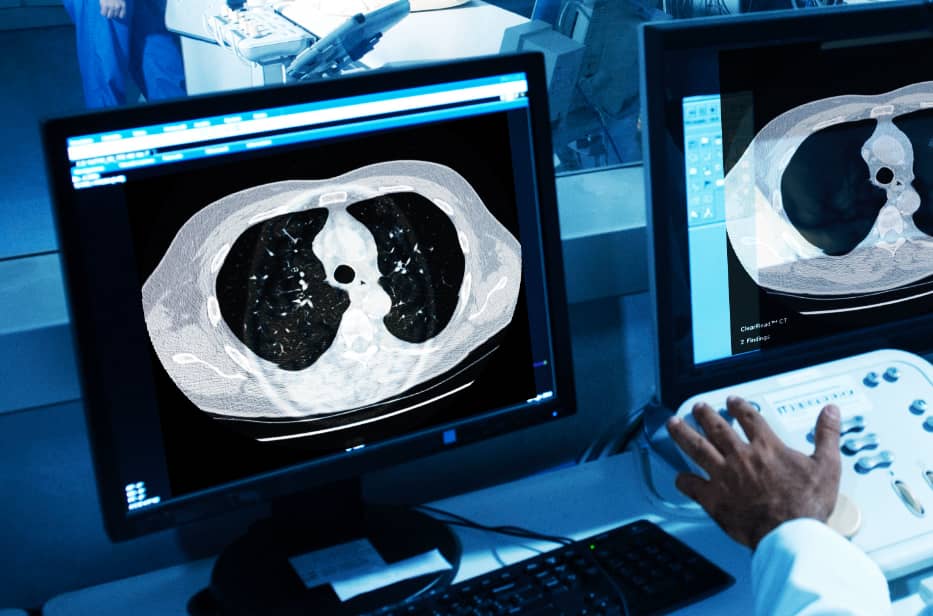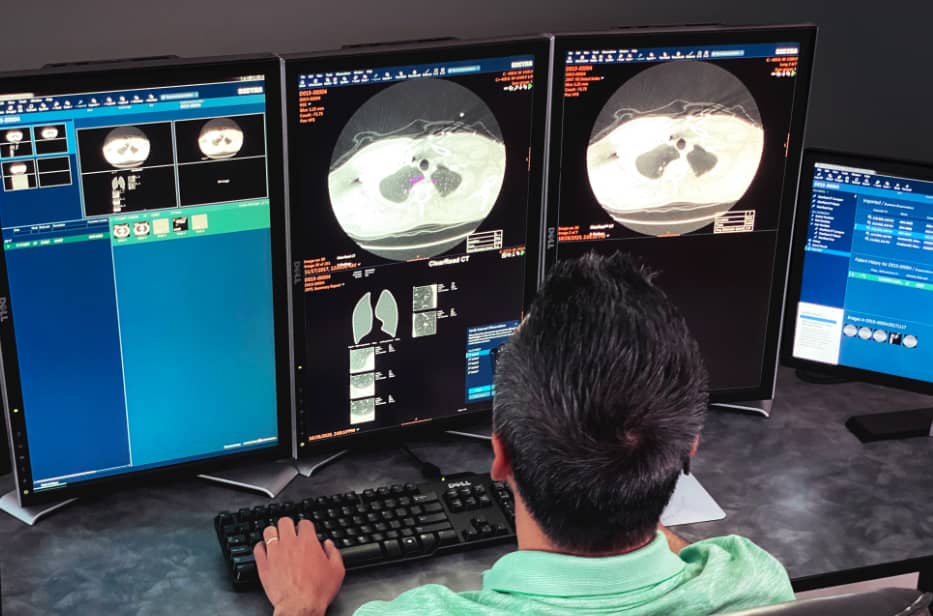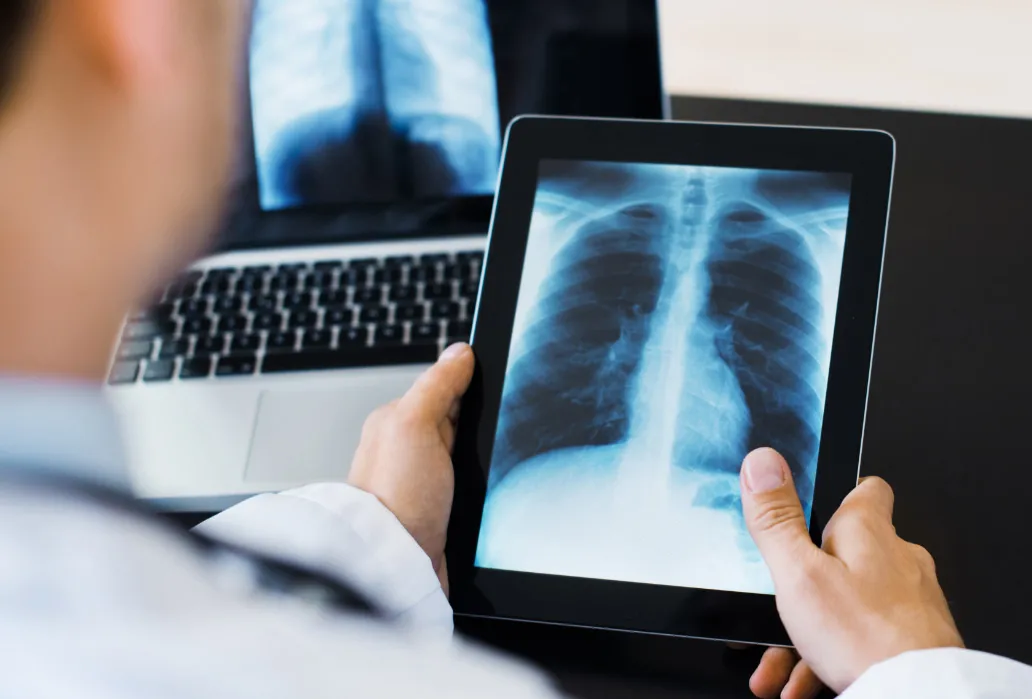Our technology is revolutionizing radiology. We’d love to work with you to help create better outcomes for patients everywhere.
The first FDA-cleared device that supports concurrent reading, allowing for faster reading with proven, superior, automatic nodule detection.

Our five FDA-cleared applications are designed to improve reading efficiency and accuracy across the hospital enterprise without additional equipment, procedures or radiation dose.

Riverain’s deep learning AI technology is FDA cleared, field tested, and clinically proven to provide real results in radiology.

Riverain Technologies advanced AI imaging software is in use by leading healthcare organizations around the world.

Peer reviews, reference accounts, and independent studies confirm that ClearRead technology is positively impacting the field of radiology.

Managing your lung program can seem daunting, whether you’re getting going, growing, or managing workflow. We’ve curated resources for you.

CHICAGO – Nov. 28, 2012 – Three studies to be presented at the Radiological Society of North America (RSNA) annual meeting report that using bone suppression and computer-aided detection (CAD) software significantly improves the detection of lung nodules on chest X-ray images.
The research also found CAD performed well on images captured by both portable and upright X-ray machines, and that most false positive marks – the marking of areas on the chest X-ray that are not lung nodules – call radiologists’ attention to other important abnormalities, including serious lung diseases, and to medical devices in or on the chest that radiologists would be able to quickly dismiss. Riverain Technologies’ ClearRead software was used in each of the studies.
Lung cancer is the leading cause of cancer death in the United States, claiming more lives than breast, colon and prostate cancer combined, according to the American Cancer Society. X-ray is one of the most common imaging tests; however, ribs and clavicles commonly obscure visibility in the chest, leading to reduced lung cancer detection rates. Riverain’s ClearRead software suppresses the ribs and clavicles on conventional chest X-ray images, providing radiologists with a clear, unobstructed view of the lungs and exposing abnormalities that might indicate disease. The software is easy to install and adopt, requiring no additional imaging equipment or staffing, and no additional radiation exposure to patients. It can be used to immediately enhance images produced by all X-ray machines throughout a hospital or health system.
Radiologist Detection of Lung Nodules Improved With Bone Suppression Software
(Embargoed for release on Wednesday, Nov. 28, at 12:01 a.m. ET)
In a study at Radbound University Nijmegen Medical Centre (RUNMC), the Netherlands, five attending radiologists and three radiology residents who were not experienced with the Riverain software detected more confirmed lung nodules using ClearRead Bone Suppression™ 2.4 software than when they evaluated the X-ray images on their own. The radiologists read 300 chest X-ray images with and without bone suppression (111 X-rays with solitary lung nodules and 189 control cases with no nodules). They detected 79 percent of the lung nodules with bone suppression, with approximately 0.3 false positive per image compared to 71 percent detection of lung nodules and 0.21 false positive per image when they reviewed the X-rays on their own. “The detection of hard-to-find nodules classified as ‘moderately subtle’ and ‘subtle’ was especially improved,” said Steven Schalekamp, M.D., a Ph.D. student in the Department of Radiology of RUNMC. “The radiologists using the bone-suppression software found 26 percent of the lung nodules that were missed entirely on conventional X-ray images.”
Radiologist Performance Also Improved with CAD Software
(Embargoed for release on Wednesday, Nov. 28, at 12:01 a.m. ET)
In a separate RUNMC study involving 300 X-rays and eight readers, the radiologists’ performance also improved when they read the images using Riverain’s CAD software, ClearRead +Detect™ 5.2, which circles suspected lung nodules on bone-suppressed X-ray images. The radiologists accurately detected 79 percent of 111 lung nodules with CAD, versus 73 percent when reviewing the bone-suppressed image without CAD.
The radiologists’ false positive rate per image was 0.28 when they used CAD and bone suppression together, and 0.23 when they used bone suppression without CAD. ClearRead +Detect found more than half of the nodules that were missed by the radiologists.
CAD Calls Radiologist Attention to Lung Nodules and Other Lung Diseases and Abnormalities
(Embargoed for release on Tuesday, Nov. 27, at 12:01 a.m. ET)
In a University of Chicago Medical Center study of 608 unselected, consecutive chest X-ray images, (479 X-rays with abnormalities, such as lung nodules, other lung diseases and scars; and 129 X-rays without significant abnormalities), Riverain’s ClearRead +Detect 5.2 CAD software on its own, without radiologist interpretation, detected 72 percent of lung nodules present, or 82 of 114 nodules. The software detected a majority of the nodules regardless of whether the image had been captured using a portable or upright X-ray machine, and even when other abnormalities, including underlying lung disease, were present.
“CAD found the majority of lung nodules in this large study, which simulates a real-world, clinical setting where the use of portable X-ray images and the presence of other abnormalities in patients’ chests make lung nodule detection challenging,” said Steve Worrell, Riverain’s Chief Technology Officer.
The CAD software had 1.3 false positives per image (0.7 on X-rays without significant abnormalities and 1.5 on images with abnormalities). Forty-one percent of the false positives across all X-rays indicated other noteworthy pathologic changes, including pneumonia, a partial or full collapse of a lung (atelectasis), fluid in the lungs (edema), other lung diseases, scars and calcifications. The higher false positive rates than previously reported can be attributed to the additional medical conditions in the lungs.
“This study serves to illustrate that most false positive marks are caused by an abnormal finding. They are only ‘false’ in the sense that they are not cancers,” said Heber MacMahon, M.B., professor of radiology and director of thoracic imaging at the University of Chicago Medical Center. “One should expect many more marks on grossly abnormal lungs than on normal X-rays.”
Nineteen percent of the false positive marks were attributed to medical devices in or on the chest, including catheter ports and electrocardiogram leads. As Dr. Schalekamp’s study suggests, the number of false positives actually reported in a clinical setting would be lower because radiologists use their judgment to quickly dismiss automatically produced marks that are caused by medical devices or grossly abnormal tissue.
“We expect that after a learning period, radiologists would be able to dismiss false positive CAD marks very quickly,” Dr. MacMahon said.
“We know that small cancers are often visible in retrospect but were not detected on earlier Xrays,” Dr. MacMahon added. “Routine use of bone suppression and CAD on chest X-rays will reduce the chances of a cancer being missed, thus improving the likelihood of diagnosing unsuspected early-stage disease.”
Our technology is revolutionizing radiology. We’d love to work with you to help create better outcomes for patients everywhere.

Subscribe to Riverain via Email
Stay up to date on the latest advancements
Riverain Technologies
3130 South Tech Blvd., Miamisburg, OH 45342
800-990-3387
| Cookie | Duration | Description |
|---|---|---|
| cookielawinfo-checkbox-analytics | 11 months | This cookie is set by GDPR Cookie Consent plugin. The cookie is used to store the user consent for the cookies in the category "Analytics". |
| cookielawinfo-checkbox-functional | 11 months | The cookie is set by GDPR cookie consent to record the user consent for the cookies in the category "Functional". |
| cookielawinfo-checkbox-necessary | 11 months | This cookie is set by GDPR Cookie Consent plugin. The cookies is used to store the user consent for the cookies in the category "Necessary". |
| cookielawinfo-checkbox-others | 11 months | This cookie is set by GDPR Cookie Consent plugin. The cookie is used to store the user consent for the cookies in the category "Other. |
| cookielawinfo-checkbox-performance | 11 months | This cookie is set by GDPR Cookie Consent plugin. The cookie is used to store the user consent for the cookies in the category "Performance". |
| viewed_cookie_policy | 11 months | The cookie is set by the GDPR Cookie Consent plugin and is used to store whether or not user has consented to the use of cookies. It does not store any personal data. |